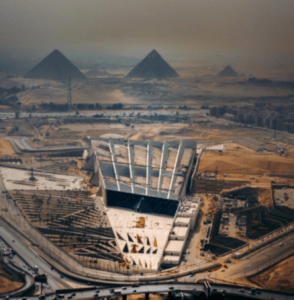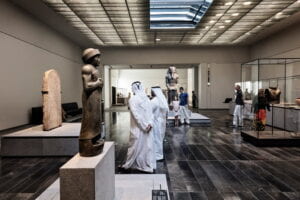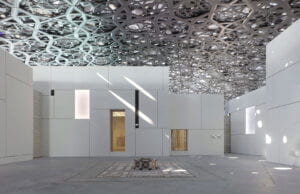Christian Greco’s lecture on museums was an eye-opening experience for me; it did not only help me realize how the role of museums is constantly changing, but it also emphasized to me again the importance of design in everything around us.
I grew up finding museums everywhere around me in the cities I lived in. I fell in love with not only how they were the door to see more of the past but also with their purpose; how they are determined to preserve the past to be seen even after thousands of years. Until a year ago, a museum was meant to be a place where the remnants of the past can be found. And as a kid, while I also liked every time I visited a museum, I couldn’t understand how and why they never thought about innovating something new; they all looked the same from the inside. For some reason, it didn’t make sense to me.
A year ago I read about the Grand Egyptian Museum, and a week ago I attendeed the lecture by Christian Gerco about the Museo Egizio, and this week I went to the Louvre Abu Dhabi. After this accumulation of exprience and hearing from different sources, I realized that my conception about museums has always been wrong. Museums are not just a place to keep artifacts; they are much more than that. They are there to both preserve, research, and keep track of the past. Most importantly, I realized that their role is constantly changing, and design is part of this change and the vision they want to achieve.
Therefore, I’m going to speak about the Grand Egyptian Museum and the Louvre Abu Dhabi, and the role of design in delivering that message.
- The Grand Egyptian Museum:
The Grand Egyptian Museum (GEM) is the world’s biggest museum that is dedicated to a single civilization. On my way to my boarding high school every week, I used to pass by it, impressed by its great Egyptian-themed design. I was, however, unaware of the bigger picture, of what this museum represents and what it symbolizes.

It was later when I realized that there was more to that. It’s not designed that way to be just a museum; it was that way to convey a message, as if this museum was the way to connect both the past and the future of the country. As you can see from the image to the right, the GEM is not only built to be considerably close to the three pyramids of Giza but it was also inspired by the pyramids themselves. The three rays shot out from each pyramid are met together in one point that defines the body of the museum.
This also correlates with the goal of the museum. The museum’s ultimate goal is to become a global center of advanced conservation and research in the field of Egyptology and archeology through both theory and practice. When Gerco spoke about the changing role of museums, this was the first thing that I thought of. Indeed, museums are not there just to preserve the artifacts but also research and understand them.

This was something that I didn’t know about, but now that I know, I appreciate the design even more as it represents the visual relationship between the project and the pyramids.
The Louvre Abu Dhabi:
Inspired by Greco’s lecture about museums, I decided to visit the Louvre Abu Dhabi for the first time. I noticed the following:
 The artifacts and artworks from different cultures are not presented based on geography or civilization
The artifacts and artworks from different cultures are not presented based on geography or civilization- Unlike all the museums I saw when I was in Egypt, the design of the interior of the museum is simple, close to minimalism
- The museum’s collection of artifacts and artworks isn’t limited to some cultures
 only; it focuses on human history as a whole.
only; it focuses on human history as a whole.
Similar to the case of the GEM, the Louvre Abu Dhabi’s design seems to be connected to the goal and vision of museum leaders and the purpose for which the museum was built.
I later discovered that the design of the outside of the Louvre, which is also the Arab world’s first universal museum, is made the way it is to resemble the shape of Arab homes here in the region, and the minimalist approach is to lead people to focus more on the artifacts. What was even more surprising is that the reason why artifacts are not presented based on geography or civilization is that, as a universal museum, the Louvre wants to show the world how all civilizations are connected, and they were put next to each other based on common aesthetics and themes in that way to emphasize that idea.
While I support the accessibility of history and antiquities for everyone and everywhere as a human heritage, I still hold on to my belief that such a thing should be done with the consent of the people to whom these antiquities originally belong. When I was a kid, my father used to tell me stories about how in the village he lived in he would see statues taken from under the ground and put into large trucks, and they were never seen again. Later, the village knew that these statues were stolen and sold. While I don’t know if this is what happened in reality or not, it saddens me to see how history can be stolen and sold in that manner. I’m not saying that these statues should remain exclusive to Egypt; what I’m saying is that this is not the appropriate way to treat the past. Unfortunately, I’m sure this was the way most Egyptian antiquities were taken outside the country to be presented in foreign museums.
In the end, I want to stress my belief that artifacts from any time are human heritage. What I only oppose here is the way through which they get transferred from one country to another, which most of the time can be depressing and humiliating. To me, museums aren’t just places that hold antiquities; I prefer the Arabic word for it, which is “متحف,” which shares the same root with the word “أتحف” which means “to amaze.” A museum is a trial to understand the past, reflect on the present, and shape the future. I’m thankful to Gerco and his lecture: indeed, they made me rethink my definition of a museum and the past it holds, and how design can be the bridge between two remote places and times.
It very interesting to read how the design of the outside of the GEM and the Louvre museum has been deliberately designed as it has a meaning behind it! Now I wonder if the structure of the museums I visited back home also have some meaning to them.
Awesome, you have visited the best places of Abu Dhabi. I have been in Abu Dhabi during my recent visit and it was just a next level. Being an arts student (history), I love the Louvre Museum and booked my tickets from here https://www.dubaiticketexpert.com/attractions/louvre-abu-dhabi-tickets/ I like the Vincent Van Gough and the fountain light.